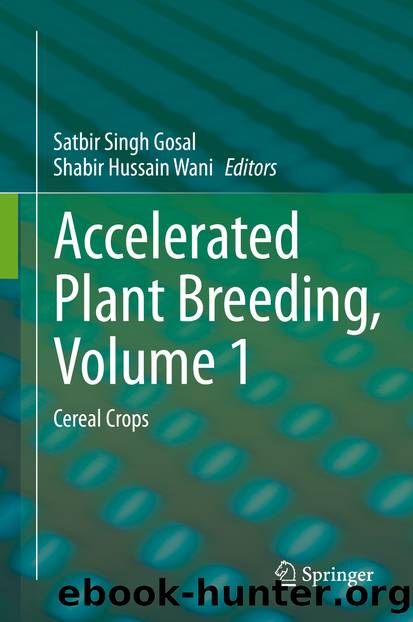Accelerated Plant Breeding, Volume 1 by Unknown

Author:Unknown
Language: eng
Format: epub
ISBN: 9783030418663
Publisher: Springer International Publishing
9.3.2 Assays for the Development of Gene/Allele-Specific Markers
In this article, we targeted three potential genes (OsSPL14, TGW6 and GS5) for transfer into an indica rice background. Gene/allele-specific markers are needed for tracking the target gene transfer. The development of allele-specific markers follows the procedure developed by Kim et al. (2016a). Once decided, the recurrent parents which will be improved by marker-assisted selection (MAS) with yield-enhancing genes, allele types of the target genes should be determined in the recurrent parents by application of allele-specific markers, polymerase chain reaction (PCR)/Sanger sequencing of the target genes or whole genome sequencing (WGS) methods. Because yield-positive alleles for some yield enhancing genes are widely dispersed in rice varieties (Kim et al. 2018, Jena et al. unpublished data), suggesting that target alleles for the selected genes maybe already present in the recurrents, especially in case of modern high-yielding varieties. Rare alleles, such as OsSPL14-WFP and TGW6-Kasalath, will be effective in most of the rice accessions, including japonica and indica varieties. Based on the results of allele typing of the recurrent parents, DNA marker development will be processed for absence of yield-enhancing alleles/genes in the recurrent parents. Acquisition of sequence information of the target genes from the direct donors and the recurrent parents using PCR-Sanger sequencing or WGS will be very helpful to design allele-specific markers and flanking polymorphic markers for MAS. Alternatively, obtaining target gene sequences of the rice accessions that are genetically close to the recurrent parents from public databases, such as the National Center for Biotechnology Information (NCBI) (https://âwww.âncbi.ânlm.ânih.âgov/â) and Rice Annotation Project Database (RAP-DB) (https://ârapdb.âdna.âaffrc.âgo.âjp/âindex.âhtml), for japonica type reference will be helpful for marker development. After preparation of the sequences for the target genes, DNA sequence variations between the donor and the recurrent for each gene will be screened through sequence alignment tools such as BioEdit (http://âwww.âmbio.âncsu.âedu/âBioEdit/âbioedit.âhtml) and NCBI blast2. Any DNA variations, including SNPs, small InDels (<20 bp) and large InDels (>25 bp), between parents can be selected for maker development, but generally functional nucleotide polymorphism (FNP), which is directly associated with phenotypes (SNPs or InDels) and large InDels located at the flanking regions, including the genes (around ±300 kb distance from the genes), are preferred for the development of allele-specific markers and for ease of marker development and clear discrimination between two alleles in agarose gel, respectively. For discriminating SNPs or very small InDels (1â5 bp) in agarose gel, cleaved amplified polymorphic sequence (CAPS) markers (Fan et al. 2009), dominant PCR markers (Kim et al. 2016a) and co-dominant tetra-primer PCR methods (Ye et al. 2001; Kim et al. 2016a) are generally used. After the development of several sets of markers, the markers should be tested with both parents and some breeding lines, including heterozygous plants, to select the clear allele discrimination and reproducible markers. Development of ideal markers is important to accurately select the target alleles and will improve the work efficiency of genotyping. Markers for three putative effective genes in indica backgrounds are presented in Table 9.2 as an example.Table 9.
Download
This site does not store any files on its server. We only index and link to content provided by other sites. Please contact the content providers to delete copyright contents if any and email us, we'll remove relevant links or contents immediately.
What's Done in Darkness by Kayla Perrin(26605)
The Fifty Shades Trilogy & Grey by E L James(19087)
Shot Through the Heart: DI Grace Fisher 2 by Isabelle Grey(19073)
Shot Through the Heart by Mercy Celeste(18944)
Wolf & Parchment: New Theory Spice & Wolf, Vol. 10 by Isuna Hasekura and Jyuu Ayakura(17125)
Python GUI Applications using PyQt5 : The hands-on guide to build apps with Python by Verdugo Leire(17006)
Peren F. Statistics for Business and Economics...Essential Formulas 3ed 2025 by Unknown(16886)
Wolf & Parchment: New Theory Spice & Wolf, Vol. 03 by Isuna Hasekura and Jyuu Ayakura & Jyuu Ayakura(16835)
Wolf & Parchment: New Theory Spice & Wolf, Vol. 01 by Isuna Hasekura and Jyuu Ayakura & Jyuu Ayakura(16459)
The Subtle Art of Not Giving a F*ck by Mark Manson(14365)
The 3rd Cycle of the Betrayed Series Collection: Extremely Controversial Historical Thrillers (Betrayed Series Boxed set) by McCray Carolyn(14151)
Stepbrother Stories 2 - 21 Taboo Story Collection (Brother Sister Stepbrother Stepsister Taboo Pseudo Incest Family Virgin Creampie Pregnant Forced Pregnancy Breeding) by Roxi Harding(13656)
Scorched Earth by Nick Kyme(12779)
Drei Generationen auf dem Jakobsweg by Stein Pia(10972)
Suna by Ziefle Pia(10895)
Scythe by Neal Shusterman(10353)
The Ultimate Python Exercise Book: 700 Practical Exercises for Beginners with Quiz Questions by Copy(9893)
D:\Jan\FTP\HOL\Work\Alien Breed - Tower Assault CD32 Alien Breed II - The Horror Continues Manual 1.jpg by PDFCreator(9864)
De Souza H. Master the Age of Artificial Intelligences. The Basic Guide...2024 by Unknown(9848)
